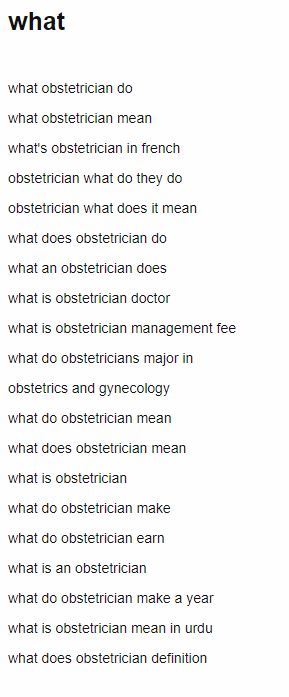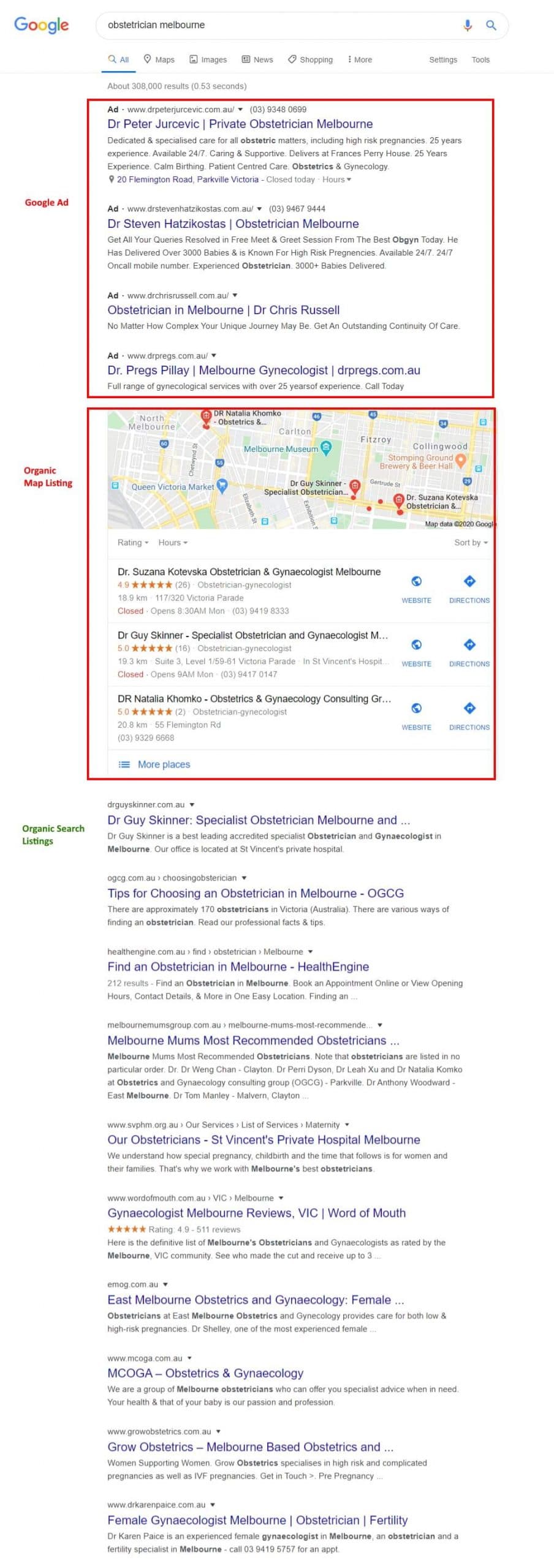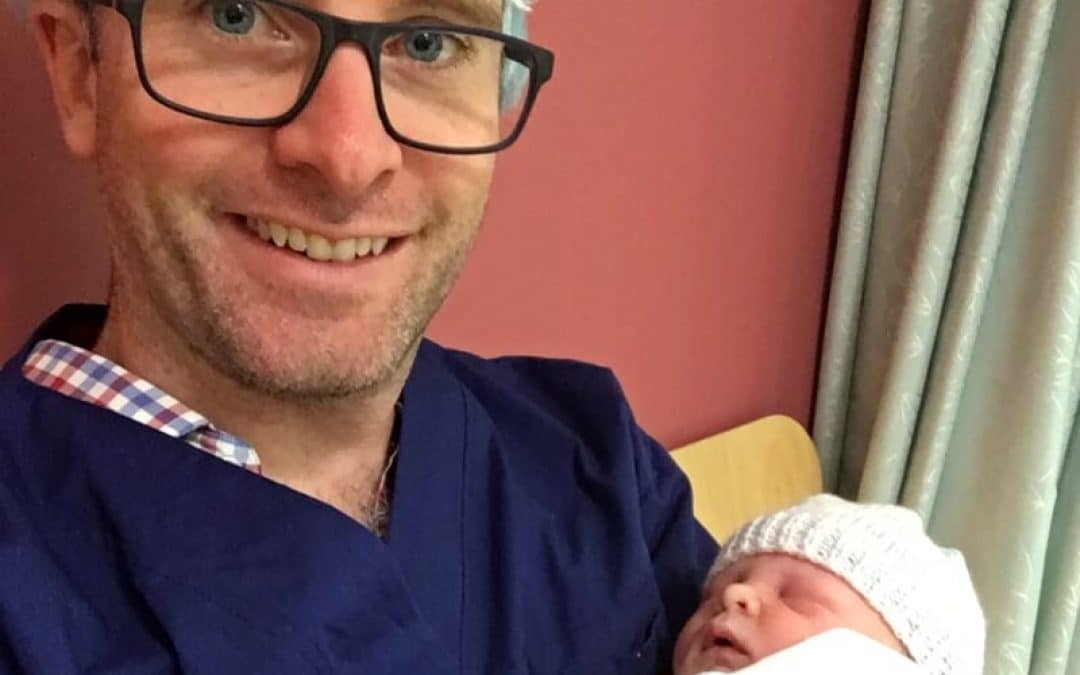Most Obstetricians, like any medical professionals, are heavily focused on caring for their patients and don’t have time to implement a website and search engine optimisation (SEO) strategy for their clinic.
Google search optimisation is a great way for Obstetricians to drive new patients to their clinic as:
- 7% of Google’s daily searches were health related (estimated by Google Health boss David Feinberd);
- Every month expected mothers search in Google to find Obstetricians; and
- A Google My Business survey found that the average business is found in 1,009 searches per month, with 84% of these coming from discovery searches.
In this post you’ll learn:
- Simple tweaks you can make to increasing your ranking in Google and traffic to your clinic website;
- More about how a professional SEO campaign should be run in order to help you screen out bad SEO providers.
If you wanted to have a chat with me about your obstetric clinic’s SEO – give me a quick call on (03) 8510 8202 or submit a contact form message at the end of this post. Due to the competitive nature of search engine optimisation, we can only work with one obstetrician per 20km radius from your clinic/hospital.
1. Find What Keywords Patients Use in Searches
There are more than six billion online searches a day worldwide so how do you know what keywords your patients are searching for?
Brainstorm different keywords you think patients will use when searching online and then use software tools to expand upon this to get a larger list of keywords to target. Keyword ideas might include:
- Obstetrician + [suburb], for example “Obstetrician Melbourne”
- Obstetrician + [hospital name], for example “Obstetrician Royal Women’s Hospital”
- Obstetrician + [special condition], for example “Obstetrician High Risk Pregnancy”
Also, you could use Answer the Public which is a free online tool (although there is a maximum number of searches you can do per day) to find out what keywords or questions people are asking when they search “obstetrician”. This is just a snippet of what came up under ‘what’:

You can see just from these searches that many people want to find out more information before they make a decision to buy, so why not be their source of information?
At the end of this process you should have a list of keyword that you want to rank for in Google.
Keyword Intent
What’s that, you ask?
Well, it’s the user’s purpose for a search. It’s what we think the user is likely to do when searching since we can’t be sure. Keyword intent is important because it helps you meet the users’ needs, by matching your content/landing pages to their intentions.
There are four types of keyword intent:
1. Commercial “high intent” intent
People are most likely to commit to buying. These search words are good indicators of commercial intent:
- Buy
- Price
- Low cost
- Discounts
- Free shipping
2. Informational intent
This is when people want to find out more information about something so it’s not often advised to try and sell something to them outright but could be a good way of gauging interest and leading to a purchase at a later stage. Common search phrases:
- How to…
- Why…
- History of…
3. Transactional intent
This type of intent lies between commercial and informational intent. This could be queries where people are looking to buy but want to read more about the product or service first. Queries can contain words like:
- Best…
- Top 10…
- …vs…
4. Navigational intent
This is when the user knows the website that they want to get to but have typed it into Google because it’s quicker, they don’t know the exact URL or they’re looking for a specific page on that website. For example, if I was looking for Digital Treasury’s blog page, it might be quicker to search for it in Google so it will take me straight there. As you can see, it’s the first page that comes up:

2. Check the Google Search Results to Types of Listings
A quick Google search for “Obstetrician” will bring up different types of results such as paid Google ads, paid Google Map listings, organic (not paid) local map listings and organic search results.
The more organic listings you can get for your business, the less money you have to fork out which is why it’s worthwhile spending the time to have an SEO strategy.
- Run a search for obstetrician and observe all the different types of results
- For “obstetrician Melbourne” for example has (see image below):
- 1 x paid Google Ad
- 3 x organic local map listings
- 10 x organic search results
- Not all of the first page of Google results are organic and you may have to get consider also implementing paid Google Ad and Google Map listing strategies.

3. Review Your Website Structure
It’s important for both patient experience and rankings to have an easy to use website. To do this, you need to ensure your content is organised clearly with a menu and URL structure.
Depending on the obstetrics services that you offer, structure your website like this:
- Home
- About Dr
- Our Services
- Antenatal and Postnatal Pelvic Floor Assessment
- Antenatal Care
- Antenatal Ultrasound Cervical
- Early Pregnancy Care
- High-risk Pregnancy Care
- Our Team
- Hospitals
- Francis Perry House
- Royal Women’s Hospital
- Monash Medical Centre
- News/Blog
- Resources
- Contact Us
- Book Online
4.Optimise Your Local Map Listing
Local map listing rankings are generating using the information you’ve added to your Google My Business page, so if you’re planning on ranking for “obstetrician + suburb”, then you definitely need get an account to get local exposure.
Claim Your Listing & Get It Verified!
If you haven’t already, go and setup your Google My Business listing here: https://business.google.com/create
In order for your listing to show up in the local map you will need to have your listing verified. To verify your listing, Google will send a postcode to your address in the mail. It says on the website it will take 6 days, but I’ve found from past experience it can take 2-4 weeks to get to Australia so make sure you get this process started as soon as you can.
Optimise Your Listing For Main Location Keywords
Make sure that you complete all the fields in Google My Business. Write as naturally as possible, but definitely include references to your location-based keywords that you’re trying to rank for in maps, for example “obstetrician Melbourne”.
Add Photos
If you check the “Insights” section of the GMB admin dashboard, it gives you statistics on a whole bunch of elements. One of which is the ‘photo views’ your GMB has had. This is a pretty good indicator to me that Google wants you to be adding images to your GMB, so upload as many of your own unique photos that you have. Before uploading them include your keywords in the image filenames as this will help you rank higher.
Add Posts
GMB also lets you add ‘posts’ which are like a social media post, but in Google. The posts allow you to add an image, description and button link.
Write a 100-word article about your main keyword. I find the easiest way to do this is think of a common question your patients ask you and then simply answer that question. For example, “What does an obstetrician do?”.
When you add an image to your post, ensure that you have optimised the image filename to include your keyword.
Add a URL link to the most appropriate page on your website and choose the text to go on the button. I prefer to use “learn more” because it isn’t asking too much of your browser to click.
Claim Your Free Mini-Website & Add a Link
GMB also lets you create a miniature website which is housed on your Google’s domain “business site”. The website is free to create and generates the content automatically from your GMB listing information. It does let you customise the website title and add another unique description. Change the title to your main keyword and add a 500+ word keyword rich article and link it back to your website homepage.
Add Your Clinic to Local Directories
Add your clinic to local citations. This is any online mention of the name, address or phone number of a local business. Citations can help Internet users discover local businesses and can also impact local search engine rankings. The top ones you should have are:
- Yellow Pages;
- Apple Maps;
- Bing Local;
- Facebook Page (yep that counts);
- True Local;
- Whitepages;
- Start Local;
- Yelp; and
- Hotfrog.
Note – It’s important that name, address and phone number and website address are identical across all citations.
5. Create human and search engine friendly content using the keywords you find
If you want to grow traffic to your website, you’ll most likely need to publish more keyword optimised content.
One of the biggest challenges with creating website content is finding the balance between what will appeal to potential patients and what will rank in Google.
From an SEO perspective, each Page or Blog Post should have a central keyword theme aimed around one keyword. That keyword should be put in the following places:
- Meta Title
- Meta Description
- URL
- <H1> tag
- 5-10 times within the body (usually accomplished without trying)
- Image filename
- Image alt tag
If I wanted to rank for the keyword “Obsterician Melbourne”, then I would apply the following formats:
- Meta Title: Obstetrician Melbourne – Dr Smith
- Meta Description: Dr Smith is an Obstetrician in Melbourne. His practice is located in Francis Perry House Grattan St & Flemington Rd, Parkville Melbourne VIC 3052
- URL: drsmith.com.au/obstetrician-melbourne (fictional, just for this example)
- <H1> tag: Looking for an Obstetrician in Melbourne?
- Image filename: obstetrician-melbourne-vic.jpeg
- Image alt tag: Obstetrician Melbourne Dr Smith
6. Get other websites talking about you and linking to you
Links to your website remain an extremely important Google ranking factor. Studies show that the number of domains linking to a page correlated with rankings more than any other factor, making obtaining links a very important piece of your SEO puzzle.
Links shows Google that your website has authority and trust on a particular topic and therefore deserves to rank higher.
At Digital Treasury, we build links in a number of ways:
- Local and niche directory listings;
- Social media accounts; and
- Websites that allow for guest posting in a related field (eg. Obstetrician blogs, medical blogs, pregnancy blogs)
7. Monitor Your Ranking Gains
You need to track your SEO campaign by looking at data and analysing what it means. Google has a number of tools for doing that such as Google Analytics and Google Search Console.
Google Analytics
Google Analytics is a free Google service that tracks and reports website traffic.
The first thing you should do is link your Analytics account to Google Webmaster Tools. Then go to Acquisition > Search Console > Queries to see all the keywords that your website is ranking for. You can also see how many impressions (searches), clicks and average position in Google.
The next thing you should do is go to Acquisition > All Traffic > Channels and then click on ‘Organic Search’ channel to see all the organic (unpaid) traffic visiting your website from search engines. This is important to look at over a 6-12 month period because you can see how your SEO campaign is performing (which hopefully improves over time).
The last part, and the most important, is looking at conversions from search engine traffic. Rankings and website traffic don’t equal sales so you need to find a way to measure conversions from your hard SEO work. First you’ll need to set up Analytics Goals, then go back to the same channels report to view ‘Goals from Organic Search traffic’.
Google Search Console
Google Search Console is a free Google service to manage your website’s search functionality. It’s a collection of reports and tools to help you fix errors as well as strategise and optimise your search engine rankings.
The first thing you should do when you log into GSC is click on ‘Search Analytics’ and then click on ‘Pages’. This will show you all the different pages on your website and ranks them from the one driving the highest amount of traffic to the least. From there you can find a list of keywords that are driving the traffic by clicking ‘Queries’.
Next you should go to that blog page or web page that’s driving that traffic and put in all the keywords into the content.
Make sure to naturally blend in all those keywords because if you just stuff those keywords into your content people will see that and that’s not good for your business.
Next, add those keywords into your meta description and your title text so Google knows what keywords you’re trying to focus on.
Finally, submit that URL within Google Search Console so it knows to trawl that page to rank for keywords. You should see an increase in search traffic in a few weeks.
SEO for obstetricians in Australia is becoming more and more competitive. If you want to rank in this space, you’re going to have structure your SEO campaign the right way.
If you have any questions, you can contact me here or leave a comment below.

